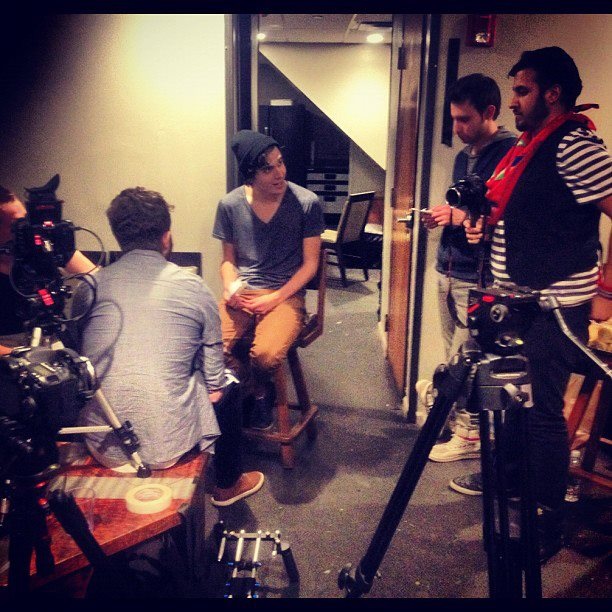Name: Chris Hoffman
Title: Co-Founder, Director of Marketing Strategy
Company: It Collective
Based in: Colorado Springs, Colo.
Established: 2012
What does your company do?
We offer film production and content marketing strategy services. On the marketing strategy side, we work with clients to identify key stories and messages that will resonate with and be shared amongst a target audience — then we help them tell those stories through the creation of that content and the execution of a marketing strategy.
On the film side, we produce everything from commercial spots to short films, and just recently finished our first feature-length production — a live concert film for Gungor, an incredibly talented band who have recently been nominated for a couple of Grammys.
How many people work for the company, and of those, how many work remotely?
We are 100% remote. Our business model is project-based, so our team changes in size depending on the number and types of projects we have in house. We went the contractor direction instead of hiring full-time employees for a number of reasons. Primarily, it allows the flexibility to resource the ideal skill sets for each project. Secondarily, hiring individuals who prefer working in a contract setting help us filter out the people who require micro-management — in other words, people who are not suited for a remote work system. The people we hire are used to managing their own time and workflow. We have around 10 team members that we work with on a regular basis.

Did you start out as a remote company?
We did, and I’d love to say that we had some great strategy behind that decision. In reality, it was made because we didn’t have the startup capital to pay for an office space. We strongly believe in the concept of bootstrapping, and have gotten off the ground without taking on any debt or external capital investment.
We’ve found that we have a great love for hosting face-to-face meetings in coffee shop or home office settings, and that our clients often love meeting in those settings as well. We recently conducted a major client review meeting on a film project in the living room of Andy Catarisano — our Co-Founder and Director of Film Production. We picked apart the final edits over homemade popcorn and cookies. I think our clients loved the experience as much as the final product. It was significantly more effective than presenting in a polished boardroom.
When we need a larger space we rent the tricked-out conference room of a local co-working establishment. Obviously there are occasions when the home office and local Starbucks won’t work, and we don’t pretend that our system will work for everyone. We’ve found a way that works for us to do business without a set physical space, and we aren’t in a hurry to change that.
What challenges did you face in setting up as a remote company?
One major challenge (for those of us that came from a traditional corporate environment) was overcoming the mentality of a 9-5 workday that had been engrained more deeply than we realized. For me personally, it has taken a very intentional effort to ask myself the right questions about my daily activities. I’ve had to learn to look at the day through the lens of, “What is the most high-impact use of my time?” As opposed to, “It’s 3 p.m. — I should be at my desk.”
U.S. work culture has conditioned employees to feel like they are fulfilling their duty to the company they work for by being in their seats for 8 hours in a day. In reality, those employees may or may not be producing anything of value. The amount of time spent at a desk is completely irrelevant to the value and quality of work, and that has been a tough lesson to learn.
What do you see as the major benefits of being a remote company?
The first major benefit is the effect it has on morale, and in turn, the increase in quality of work and dedication to the company.
Here is one very practical example of this benefit: Commute time.
I’d love for someone to give me a reason that justifies not giving one of your staff 200 hours of their lives back each year in exchange for zero productivity loss.
Think about how ridiculous it is to demand that an employee sit in rush hour for an hour or more each morning and evening, just to be in by 9 a.m. and leave at 5 p.m. How simple of a switch would it be to allow that team member to work from home until 10 a.m., then arrive at the office in 30 minutes or less with no traffic? That switch translates to well over 200 hours of time given back to that person every year to do as he or she pleases — to spend extra time with family, invest in a personal project, or just take some additional space for decompression.
I’d love for someone to give me a reason that justifies not giving one of your staff 200 hours of their lives back each year in exchange for zero productivity loss. An unwillingness to discuss these types of changes to a work schedule that provide such tangible benefits is just plain arrogance on the part of a management team.
A second huge benefit is the expansion of the talent pool that it provides for us. Instead of being limited to the labor pool within 100 miles of our location, we literally have worldwide talent at our fingertips. We regularly work with a film colorist that lives in Sydney, Australia. The quality of work that we received was vastly superior than anything within our immediate geographic area.
One really interesting thing about working with international teams is that you have almost 24 straight hours of productivity at your disposal. We’d do work in the U.S. on the project, meet briefly at the end of the day with our team member in Sydney before signing off, and then turn it over to him to continue the work. It’s an amazing experience to go to bed, get a great night’s sleep and wake up to a project that is further along than when you left it.
The other really major benefit for us is providing the freedom to tailor the work environment to the type of work being performed. An example of this that really stands out to me is on one of our recent projects, which was a feature-length film. Editing a 90-minute film together is one of the most incredibly detailed processes I’ve ever seen, and it requires a huge amount of focus and precision. We worked an amazing team of editors for this project — the kicker was that they preferred to do their editing nocturnally, from about 10 p.m. to 8 or 9 a.m. The world is quiet then — there are zero interruptions and that was their period of ultimate creativity and effectiveness. A remote work environment allowed us to say yes to that request, and the results were outstanding.
Any advice for other companies who are considering going remote?
The thing about remote work is that it magnifies existing dysfunction in the workplace. An organization with a highly functional team and a deep understanding of role clarity and how to work together in an effective manner is going to have a much easier time transitioning to a remote work structure. A dysfunctional team is going to have a much more difficult time making that leap, because the freedom of working remotely magnifies those inefficiencies.
A physical office space has long been used as a safety net for managers to push the the messes of their team dynamics under the rug as opposed to addressing them. Being able to walk down the hallway every 15 minutes to micromanage employees can (sometimes) cover up poor hiring decisions. It can compensate for a failure to plan. It can also provide a false sense of security for a manager who needs to micromanage to feel effective in their position. Working remotely immediately removes those safety nets and exposes the true functionality of a team. If you’re thinking about making the leap to a remote work environment, it’s important to ask these questions about your team and be very honest in your answers.
Visit It Collective.

Miles at dojo4
on 31 Dec 13Awesome to see a fellow Colorado company on SVN.
It’s great to see someone outside the development industry talk about working remotely and it working for them. Very impressive that you guys can coordinate editing a movie remotely, nice job.
Also couldn’t agree more with your slam on traditional offices:
This discussion is closed.